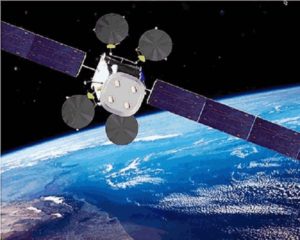

 High-throughput satellite (HTS) constellations have quickly become transformative technology for satellite communications, far surpassing the bandwidth speed and throughput possible with existing satellite communications.
High-throughput satellite (HTS) constellations have quickly become transformative technology for satellite communications, far surpassing the bandwidth speed and throughput possible with existing satellite communications.
Earlier this month SatCom Frontier published a story explaining the difference between open vs. closed HTS architecture. Open architecture systems give government end users more control over their data and more flexibility regarding how to take advantage of HTS technology. We also shared a case study explaining how the U.S. Marine Corps (USMC) has made use of the Intelsat EpicNG platform, providing HTS capabilities for WIN-T Increment 2 while both at-the-halt and on-the-move.
We now have proven test results documenting the gains in performance, flexibility and resilience that government users have experienced with Intelsat EpicNG. (Click here for the full report.)
Bringing Superior Capability to Airborne ISR
Because of limited space on the aircraft, airborne intelligence, surveillance and reconnaissance (AISR) missions often use smaller, so-called disadvantaged, satellite terminals. This need is driven by size, weight and power (SWaP) and other operational constraints. The high effective isotropic radiated power (EIRP) and antenna gain to noise temperature (G/T) performance provided by Intelsat EpicNG satellites are extremely well suited for these smaller terminals.
Information dominance is a key enabler in today’s military operations.
The higher G/T provided by Intelsat EpicNG-class satellites translates into higher transmission rates from existing terminals and/or less terminal EIRP per transmitted Mbps. Gilat Satellite Networks approached Intelsat to do some testing over Intelsat EpicNG in support of its partnership with Diamond Aircraft on the DA42 MPP Guardian aircraft designed for homeland security applications.

Gilat brought its BlackRay 71 (BR-71) airborne terminal with a mechanically steered six-inch square flat panel array, to Intelsat’s Mountainside Teleport near Hagerstown, Maryland. In addition to small manned aircraft, the Gilat terminal is designed for a new generation of small Class III tactical unmanned aircraft systems (TUASs), such as the RQ-21 Blackjack, and Shadow M2 that are coming into service for ISR operations, and other non-military government and commercial applications.
Engineers sent data from the small airborne antenna to the Mountainside teleport via the Intelsat 29e satellite at a rate of 3.9 Mbps with an efficiency of 0.26 bits/Hz, occupying only 15.2 MHz of bandwidth. This compares to an uplink rate of about 1.8 Mbps and efficiency of 0.09 bits/Hz achieved with a conventional wide-beam satellite that would occupy 20 MHz of bandwidth. The HTS link was effectively twice the data rate and almost 3x more efficient than traditional wide-beam satellites.
Enhancing Widely-Deployed Ground Network Technology for the Army
The iDirect Evolution satellite router is widely adopted in the U.S. government with ground-based fixed/deployable networks across the DoD such as the USSOCOM C2 networks, the Army CSS-VSAT network, and the DISA Enterprise SATCOM Gateway Modem (ESGM) initiative.
IGC conducted iDirect Evolution performance testing on IS-29e on a number of DoD user terminals from Tampa Microwave, L-3 GCS Panther II, Harris Seeker, GATR Flex, TECOM KuStream, and Rantec to measure capability and verify gains on the first Intelsat EpicNG satellite. IGC specifically chose test assets that reflected the combatant commands desire to field systems with lower SWaP. To compare the performance between a legacy wide-beam satellite and the high-throughput satellite, IGC established two test networks.
First, IGC set up a control network on the Intelsat Galaxy-19 satellite utilizing 12 MHz for the forward and return links each. Using the hub terminal at Intelsat’s Mountainside Teleport and a 65cm Panther terminal, engineers established a TDMA network. The 65cm Panther terminal could only achieve 3 Mbps inbound (0.25 bits/Hz) and 0.8 Mbps (0.067 bits/Hz) outbound.
Then, IGC set up a test network on the IS-29e satellite utilizing the same 12 MHz for the forward and return links each. Engineers used the same hub terminal at Mountainside and various remote terminals to again establish a TDMA network.
On the Intelsat EpicNG satellite, the 65cm Panther terminal achieved 19.5 Mbps inbound (1.63 bits/Hz) and 10.7 Mbps (1.19 bits/Hz) outbound, yielding data rate improvements of 652 and 1338 percent, respectively. These dramatic improvements in broadband speeds to the tactical edge enable new network capabilities and applications not normally associated with traditional VSAT communications such as high definition full-motion video and high data rate backhaul.
More Resilient Commercial SATCOM
Intelsat EpicNG satellites can successfully provide mitigation to interferences transmitted from both out-of-beam and in-beam locations. Out-of-beam interference mitigation is accomplished by the small spot-beam coverage design. As such, out-of-beam interference is always mitigated and does not require any action from end users. In-beam interference mitigation is possible due to the capabilities of the digital payload on Intelsat EpicNG satellites. IGC personnel can actively identify the interferer and reconfigure the payload in near real-time.
Intelsat EpicNG introduces an even higher level of protection to meet the resiliency requirements of government customers. Low-probability of intercept (LPI) and jamming-resilience greatly enhance anti-jamming capabilities on Intelsat EpicNG satellites, regardless of modem technologies. While frequency hopping modems provide some level of LPI, Intelsat EpicNG offers other interference-mitigation capabilities that include on-board power monitoring; notch filtering of interferers/unauthorized users; and monitoring, re-routing, geo-location and identification of interferers.
Information dominance is a key enabler in today’s military operations. U.S. forces since WWII have always possessed this dominance versus any potential adversary. Today’s government networks continuously grow in size and complexity while remote systems on the network edge decrease in SWaP. These innovations deliver great benefits but are highly dependent on the increased capabilities that HTS platforms offer. With more platforms, missions, and services battling for bandwidth, the increased bandwidth and speed delivered by systems like Intelsat EpicNG are vital to maintaining ISR superiority in space.
The use case test results above document the performance gains of open HTS. The satellite networks of tomorrow are operational today, and ready to serve our customers.